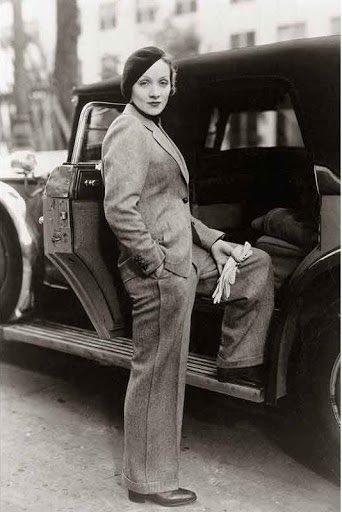Marlène Dietrich was not arrested by the police in 1933 in Paris because she wore trousers
Advertisement
We find the photo accompanied by this statement on Facebook here, or there, but also on the “Historical Images” account where it has been shared more than twenty thousand times. On Twitter, we find it in French, in English, in Portuguese, or in Spanish.
The photo would have been popularized first with the mention of his arrest in an English post on the site Reddit, in the section “Old School Cool” which shares photos and videos of “the coolest people in history”. post has been commented nearly 1300 times.
Thanks to the archives, it is possible to find the exact context of this photo
Among these comments, that of "gerardmenfin": the user who often publishes deconstructions of false historical information is alerted by the viral post. After a few hours of research, his detailed explanation is published as a comment then reposted on the Reddit page “Ask Historians”, then shared on Twitter.
According to Gilles Tran (gerardmenfin on Reddit), contacted by our editorial staff, it is possible to find the complete story behind this photo: Marlene Dietrich is not being arrested for wearing pants, but simply coming out of a train and walks accompanied by her husband, Rudolf Sieber, to her left.
Thanks to the Retro News archive site, he was able to find traces of the actress and singer in the French newspapers of the time. After crossing the Atlantic on a Paramount-granted ferry, she took a train to Cherbourg, arriving at Gare Saint-Lazare on May 19, 1933. The news of her arrival in Paris, in a held in a style considered very masculine at the time, is widely commented on by the French press.
“The Pants of Marlène Dietrich” titles the Work on May 21, “Marlène, the woman… as a man” points out Comœdia on May 20, or even “The star (...) arrived at the Saint-Lazare station dressed in elegant young man” comments Le Quotidien. Many cartoons are also published by the press after the event.
Screenshots of a selection of articles, photos and interviews on Marlène Dietrich published in the French press at the time.{{ scope.counterText }}{{ scope.counterText }}Screenshots of 'a selection of cartoons and a photo montage published in the French press at the time.{{ scope.counterText }}{{ scope.counterText }}
But no mention is made of an arrest of the star by the French police. According to Gilles Tran, given the reputation of Marlène Dietrich, her arrest would necessarily have been mentioned in the newspapers. Marlène Dietrich's daughter, Maria, was also dressed like her mother, as can be seen at the top right of the Paris Soir newspaper of May 21, 1933.
In addition, some photos of the same moment taken by the Keystone Paris agency can be found on Getty Images, as well as in the newspapers of the time, without one being able to see a police arrest there. We also find the original photo from which the viral image is taken, cropped.
Screenshots of photos from the same moment{{ scope.counterText }}{{ scope.counterText }}In short, according to Gilles Tran, the event of this May 19, 1933 very covered by the French newspapers was not that of an arrest of the actress Marlène Dietrich, but “only” the arrival in Paris of this international star , in an outfit that denotes at the time, although very fashionable in Hollywood.
Marlene Dietrich was invited that evening by Madame Chiappe, wife of the Paris police chief, and it was unlikely that she would be publicly threatened at that time:
The actress didn't break any French laws by wearing pants
But then, what about the question of the ban on the wearing of trousers? In his analysis published on Reddit, Gilles Tran explains that there was indeed an ordinance from the Paris police headquarters dated November 7, 1800. It specified that “any woman wishing to dress as a man must report to the police headquarters to obtain authorization and that this can only be given on the basis of a certificate from a health officer”.
This order was more dissuasive than repressive: no penalty was associated with it. The goal was to limit access to certain trades to women posing as men, as can be read in this article by historian Christine Bard.
With the evolution of the clothing of Parisian women, the prescription became obsolete, and was no longer used at all from the beginning of the 1900s. The controversies surrounding this prescription would have created this rumor about Marlène Dietrich, according to Gilles Tran .
In 2013, the fact that this ordinance is still theoretically in force was underlined by Alain Houpert, senator from the Côte d'Or (UMP-R), in a question addressed to the Minister of Women's Rights. In its response, the ministry explained that the ordinance was in fact incompatible with the values of the French Constitution of 1946 as well as the European Convention on Human Rights, and that it was therefore no longer applicable de facto.
If you want to read more historical checks, you can find this article on a file photo of Che Guevara allegedly “shooting women”.
Download the app








